'1회 충전에 91km' 국산 전기차 값 확 낮춘다
국내 첫 양산형 전기차 레이입니다. 지난해 말에 공개됐지만, 판매는 이제서야 시작했습니다. 차값 때문입니다. 제조사와 정부가 밀고 당기다가 한 대에 4,500만 원으로 결정이 됐습니다. 아직은 전기차의 원가를 낮추기가 어려운 게 현실입니다. 하지만 3년만 지나고 나면 다를 거라는 기대가 높습니다. 차값을 낮추려면 원가의 절반을 차지하는 배터리 가격이 떨어져야 합니다. 기술 개발 속도를 감안하면 배터리값은 2015년엔 지금의 3분의 1 수준으로 하락할 것으로 보여 3년 뒤면 본격적으로 전기차 시장이 열릴 걸로 업계는 기대합니다.
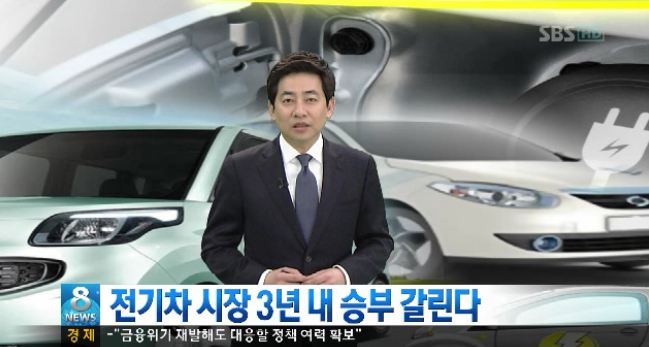
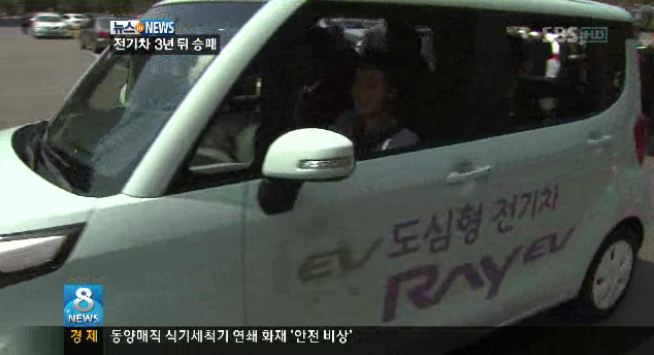
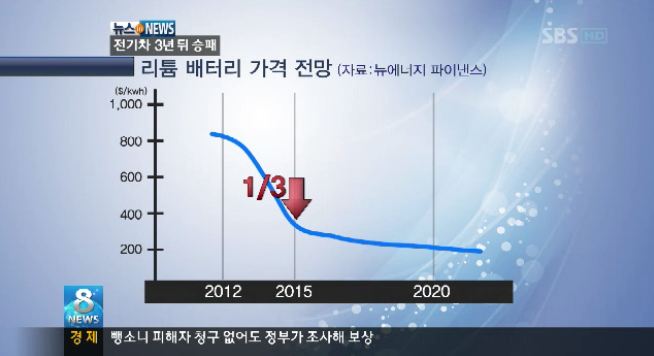
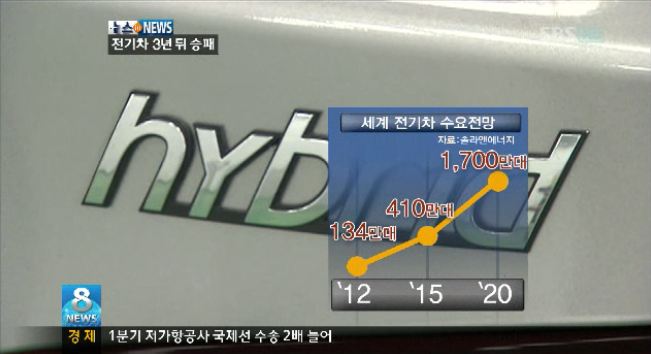
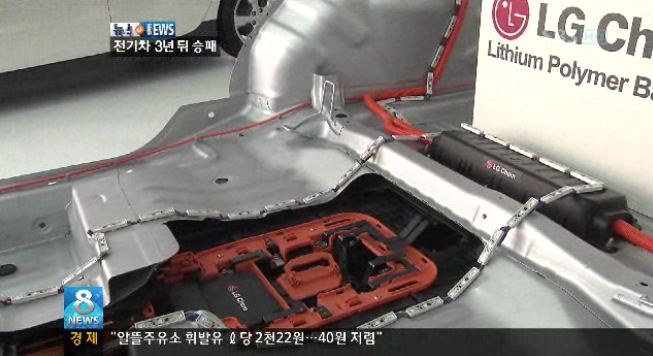
관련 뉴스 동영상을 보기를 원하시는 분들은 아래 동영상을 참조하세요.
SBS 서경채 기자의 보도입니다.
| 제목 | 조회 | 등록일 |
|---|---|---|
| 몸속 혈액으로 전기를 만든다고? | 16292 | 2012-06-11 |
| 서울대 공과대학 예술 교과목을 새로운 정규 수업으로 편성 (1) | 16561 | 2012-05-22 |
|
삼성전자 세계 최초 유기발광다이오드(OLED) TV 양산형 모델 개발
|
50290 | 2012-05-11 |
|
쓸데없이 미적분 왜 배우냐고? 답해줄게!
|
30902 | 2012-05-09 |
|
‘희망의 빛’ 전자 망막이 시각장애인들에게 새로운 삶을 제공
|
62994 | 2012-05-06 |
|
더 이상 미래의 얘기가 아닌 전기 자동차
|
179487 | 2012-04-28 |
|
삼성, 뇌에 칩 이식-인간제어 美 특허
|
14087 | 2012-04-26 |
|
리차드 파인만: There’ s Plenty of Room at the Bottom
|
91717 | 2012-04-23 |
|
조지 화이트사이드: 우표 한 장 크기의 실험실
|
19960 | 2012-04-20 |
|
전자현미경으로 액체 속 원자 관찰 성공… 혈액 안 바이러스 분석 등 활용영역 넓어
|
15875 | 2012-04-06 |
|
우리대학교, 지난해 외부지원 연구비 수주액 역대 최고치 경신
|
12323 | 2012-03-23 |
|
만능초점 리트로 카메라 출시
|
15116 | 2012-03-02 |
| KAIST 학부생 논문 세계적 저널 표지 장식 [1] (5) | 12218 | 2012-02-21 |
| 삼성 핵심인재 3천명 영입 | 13705 | 2012-01-27 |
|
헐크 개미 몇 배나 큰 벌을 번쩍
|
12312 | 2012-01-27 |
|
알렉산더 그라함 벨이 생각한 하늘을 떠나닐 수 있는 대형 구조물 제작
|
17169 | 2012-01-12 |
|
테크노마트 옥상에 웬 50t 철판?… 국내기술로 진동 잡는다.
|
18648 | 2011-12-09 |
| 神의 입자 ‘힉스 (Higgs)’ [2] (90) | 290087 | 2011-12-09 |
| 걸으면서 충전하는 신발충전 기술의 발전 | 15692 | 2011-12-04 |
| 신규 홈페이지를 개설하며... | 11864 | 2011-12-03 |
The history of the electric vehicle began in the mid-19th century. An electrical vehicle held the vehicular land speed record until around 1900. The high cost, low top speed and short range of electric vehicles, compared to later internal combustion vehicles, led to a worldwide decline in their use. At the beginning of the 21st Century, interest in electrical and other alternative fuel vehicles has increased due to growing concern over the problems associated with hydrocarbon fueled vehicles, including damage to the environment caused by their emissions, and the sustainability of the current hydrocarbon-based transportation infrastructure.
Contents
[hide][edit] 1830s to 1900s: Early history
The invention of the electric vehicle is attributed to various people. In 1828, Ányos Jedlik, a Hungarian who invented an early type of electric motor, created a tiny model car powered by his new motor. In 1834, Vermont blacksmith Thomas Davenport, the inventor of the first American DC electrical motor, installed his motor in a small model car, which he operated on a short circular electrified track.[1] In 1835, Professor Sibrandus Stratingh of Groningen, the Netherlands and his assistant Christopher Becker created a small-scale electrical car, powered by non-rechargeable primary cells.[2] In 1838, Scotsman Robert Davidson built an electric locomotive that attained a speed of 4 mph (6.4 km/h).[3] Between 1832 and 1839, Robert Anderson of Scotland invented a crude electrical carriage.[4] A patent for the use of rails as conductors of electric current was granted in England in 1840, and similar patents were issued to Lilley and Colten in the United States in 1847.[5] Rechargeable batteries that provided a viable means for storing electricity on board a vehicle did not come into being until the 1840s.[citation needed]
The invention of improved battery technology, including efforts by Gaston Plante in France in 1865,[6] as well as his fellow countryman Camille Faure in 1881,[7] paved the way for electric cars to flourish in Europe. An electric-powered two-wheel cycle was put on display at the 1867 World Exposition in Paris by the Austrian inventor Franz Kravogl.[8] France and Great Britain were the first nations to support the widespread development of electric vehicles.[4] The lack of natural fossil resources in Switzerland resulted in the tiny European nation's rapid electrification of its railway network to reduce its dependence on foreign energy. In November 1881, French inventor Gustave Trouvé demonstrated a working three-wheeled automobile at the International Exhibition of Electricity in Paris.[9] English inventor Thomas Parker, who was responsible for innovations such as electrifying the London Underground, overhead tramways in Liverpool and Birmingham, and the smokeless fuel coalite, claimed to have perfected a working electric car as early as 1884.[10]
Electric trains were also used to transport coal out of mines, as their motors did not use up precious oxygen. Before the pre-eminence of internal combustion engines, electric automobiles also held many speed and distance records.[11] Among the most notable of these records was the breaking of the 100 km/h (62 mph) speed barrier, by Camille Jenatzy on April 29, 1899 in his 'rocket-shaped' vehicle Jamais Contente, which reached a top speed of 105.88 km/h (65.79 mph). Also notable was Ferdinand Porsche's design and construction of an all-wheel drive electric car, powered by a motor in each hub,[12] which also set several records in the hands of its owner E.W. Hart.
[edit] The rise of the electric vehicle in America
Though Thomas Davenport was among the first to install an electric motor into a vehicle, an electric car in the conventional sense was not developed until 1890 or 1891, by William Morrison of Des Moines, Iowa; the vehicle was a six-passenger wagon capable of reaching a speed of 14 miles per hour (23 km/h). It was not until 1895 that Americans began to devote attention to electric vehicles, after A.L. Ryker introduced the first electric tricycles to the U.S., by that point, Europeans had been making use of electric tricycles, bicycles, and cars for almost 15 years. Many innovations followed, and interest in motor vehicles increased greatly in the late 1890s and early 1900s. In 1897, electric vehicles found their first commercial application as a fleet of electrical New York City taxis, built by the Electric Carriage and Wagon Company of Philadelphia, was established. Electric cars were produced in the U.S. by Anthony Electric, Baker, Columbia, Anderson, Edison, Studebaker, Riker, and others during the early 20th century. In 1911, the first gasoline-electric hybrid car was released by the Woods Motor Vehicle Company of Chicago. The hybrid was a commercial failure, proving to be too slow for its price, and too difficult to service.[13]
Due to technological limitations and the lack of transistor-based electric technology, the top speed of these early electric vehicles was limited to about 32 km/h (20 mph).[citation needed] Despite their relatively slow speed, electric vehicles had a number of advantages over their early-1900s competitors. They did not have the vibration, smell, and noise associated with gasoline cars. Changing gears on gasoline cars was the most difficult part of driving, and electric vehicles did not require gear changes. While steam-powered cars also had no gear shifting, they suffered from long start-up times of up to 45 minutes on cold mornings. The steam cars had less range before needing water than an electric car's range on a single charge. Electric cars found popularity among well-heeled customers who used them as city cars, where their limited range proved to be even less of a disadvantage. The cars were also preferred because they did not require a manual effort to start, as did gasoline cars which featured a hand crank to start the engine. Electric cars were often marketed as suitable vehicles for women drivers due to this ease of operation; in fact, early electric cars were stigmatized by the perception that they were "women's cars", leading some companies to affix radiators to the front to disguise the car's propulsion system.
Acceptance of electric cars was initially hampered by a lack of power infrastructure, but by 1912, many homes were wired for electricity, enabling a surge in the popularity of the cars. At the turn of the century, 40 percent of American automobiles were powered by steam, 38 percent by electricity, and 22 percent by gasoline. 33,842 electric cars were registered in the United States, and America became the country where electric cars had gained the most acceptance.[14] While basic electric cars cost under $1,000 (in 1900 dollars, roughly $28,000 today), most early electric vehicles were massive, ornate carriages designed for the upper-class customers that made them popular. They featured luxurious interiors, replete with expensive materials, and averaged $3,000 by 1900 (roughly $84,000 today). Sales of electric cars peaked in 1912.
In order to overcome the limited operating range of electric vehicles, and the lack of recharging infrastructure, a exchangeable battery service was first proposed as early as 1896.[15] The concept was first put into practice by Hartford Electric Light Company through the GeVeCo battery service and initially available for electric trucks. The vehicle owner purchased the vehicle from General Vehicle Company (GVC, a subsidiary of the General Electric Company) without a battery and the electricity was purchase from Hartford Electric through an exchangeable battery. The owner paid a variable per-mile charge and a monthly service fee to cover maintenance and storage of the truck. Both vehicles and batteries were modified to facilitate a fast battery exchange. The service was provided between 1910 to 1924 and during that periord covered more than 6 million miles. Beginning in 1917 a similar successful service was operated in Chicago for owners of Milburn Light Electric cars who also could buy the vehicle without the batteries.[15]
[edit] 1920s to 1980s: Gasoline dominates
After enjoying success at the beginning of the century, the electric car began to lose its position in the automobile market. This was brought about by a number of developments. By the 1920s, improved road infrastructure was being created between American cities; in order to make use of these roads, vehicles with greater range than that offered by electric cars were needed. The discovery of large reserves of petroleum in Texas, Oklahoma, and California led to the wide availability of affordable gasoline, making gas-powered cars cheaper to operate over long distances. Electric cars were limited to urban use by their slow speed (no more than 24–32 km/h or 15–20 mph[14]) and low range (30–40 miles or 50–65 km[14]), and gasoline cars were now able to travel farther and faster than equivalent electrics. Gasoline cars became ever easier to operate thanks to the invention of the electric starter by Charles Kettering in 1912, which eliminated the need of a hand crank for starting a gasoline engine, and the noise emitted by ICE cars became more bearable thanks to the use of the muffler, which had been invented by Hiram Percy Maxim in 1897. Finally, the initiation of mass production of gas-powered vehicles by Henry Ford brought the price as low $440 in 1915 (equivalent to roughly $10,000 today),[16] and $360 by 1916 (roughly $7,700 today). By contrast, the price of similar electric vehicles continued to rise; in 1912, an electric roadster sold for $1,750 (roughly $42,000 in today), while a gasoline car sold for less than half of that, $650 (roughly $16,000 today).[4]
Studebaker electric cars were sold until the sales peak reached in 1912; Ryker, Morrison, Anthony Electric, and the Electric Carriage and Wagon Company of Philadelphia, all continued to sell their cars until 1914. Electric vehicles became popular for certain applications where their limited range did not pose major problems. Forklift trucks were electrically powered when they were introduced by Yale in 1923.[17] In Europe, especially the United Kingdom, milk floats were historically powered by electricity. Electric golf carts were produced by Lektro as early as 1954.[18] By the 1920s, the heyday of electric cars had passed, and a decade later, the American electric automobile industry had effectively disappeared. A thorough examination into the social and technological reasons for the failure of electric cars was discussed by author Michael Brian in his book Taking Charge: The Electric Automobile in America.[19]
Years passed without a major revival in the use of electric cars. Fuel-starved European countries fighting in World War II experimented with electric cars, such as the British milk floats, but overall, while ICE development progressed at a brisk pace, electric vehicle technology stagnated. In the late 1950s, Henney Coachworks and the National Union Electric Company, makers of Exide batteries, formed a joint venture to produce a new electric car, the Henney Kilowatt. The car was produced in 36-volt and 72-volt configurations; the 72-volt models had a top speed approaching 96 km/h (60 mph) and could travel for nearly an hour on a single charge. Despite the Kilowatt's improved performance with respect to previous electric cars, consumers found it[citation needed] too expensive compared to equivalent gasoline cars of the time, and production ended in 1961.
In 1959, American Motors Corporation (AMC) and Sonotone Corporation announced a joint research effort to consider producing an electric car that was to be powered by a "self-charging" battery.[20] AMC had a reputation for innovation in economical cars while Sonotone had technology for making sintered plate nickel-cadmium batteries that could be recharged rapidly and weighed less than traditional lead-acid versions.[21] That same year, Nu-Way Industries showed an experimental electric car with a one-piece plastic body that was to begin production in early 1960.[20]
The U.S. and Canada Big Three automakers had their own electric car programs during the late-1960s. In 1967, much smaller AMC partnered with Gulton Industries to develop a new battery based on lithium and a speed controller designed by Victor Wouk.[22] A nickel-cadmium battery supplied power to an all-electric 1969 Rambler American station wagon.[22] Other "plug-in" experimental AMC vehicles developed with Gulton included the Amitron (1967) and the similar Electron (1977). More battery-electric concept cars appeared over the years, such as the Scottish Aviation Scamp (1965),[23] the Enfield 8000 (1966)[24] and two electric versions of General Motors gasoline cars, the Electrovair (1966) and Electrovette (1976).[25] None of them entered production.
On July 31, 1971, an electric car received the unique distinction of becoming the first manned vehicle to be driven on the Moon; that car was the Lunar rover, which was first deployed during the Apollo 15 mission. The "moon buggy" was developed by Boeing and Delco Electronics, and featured a DC drive motor in each wheel, and a pair of 36-volt silver-zinc potassium hydroxide non-rechargeable batteries.
[edit] 1990s to present: Revival of mass interest
After years outside the limelight, the energy crises of the 1970s and 80s brought about renewed interest in the perceived independence electric cars had from the fluctuations of the hydrocarbon energy market. At the 1990 Los Angeles Auto Show, General Motors President Roger Smith unveiled the GM Impact electric concept car, along with the announcement that GM would build electric cars for sale to the public.
In the early 1990s, the California Air Resources Board (CARB), the government of California's "clean air agency", began a push for more fuel-efficient, lower-emissions vehicles, with the ultimate goal being a move to zero-emissions vehicles such as electric vehicles.[26][27] In response, automakers developed electric models, including the Chrysler TEVan, Ford Ranger EV pickup truck, GM EV1 and S10 EV pickup, Honda EV Plus hatchback, Nissan lithium-battery Altra EV miniwagon and Toyota RAV4 EV. The automakers were accused of pandering to the wishes of CARB in order to continue to be allowed to sell cars in the lucrative Californian market, while failing to adequately promote their electric vehicles in order to create the impression that the consumers were not interested in the cars, all the while joining oil industry lobbyists in vigorously protesting CARB's mandate.[27] GM's program came under particular scrutiny; in an unusual move, consumers were not allowed to purchase EV1s, but were instead asked to sign closed-end leases, meaning that the cars had to be returned to GM at the end of the lease period, with no option to purchase, despite lessor interest in continuing to own the cars.[27] Chrysler, Toyota, and a group of GM dealers sued CARB in Federal court, leading to the eventual neutering of CARB's ZEV Mandate.
After public protests by EV drivers' groups upset by the repossession of their cars, Toyota offered the last 328 RAV4-EVs for sale to the general public during six months, up until November 22, 2002. Almost all other production electric cars were withdrawn from the market and were in some cases seen to have been destroyed by their manufacturers.[27] Toyota continues to support the several hundred Toyota RAV4-EV in the hands of the general public and in fleet usage. GM famously de-activated the few EV1s that were donated to engineering schools and museums.
Throughout the 1990s, interest in fuel-efficient or environmentally friendly cars declined among Americans, who instead favored sport utility vehicles, which were affordable to operate despite their poor fuel efficiency thanks to lower gasoline prices. American automakers chose to focus their product lines around the truck-based vehicles, which enjoyed larger profit margins than the smaller cars which were preferred in places like Europe or Japan. In 1999, the Honda Insight hybrid car became the first hybrid to be sold in North America since the little-known Woods hybrid of 1917.
Hybrid electric vehicles, which featured a combined gasoline and electric powertrain, were seen as a balance, offering an environmentally friendly image and improved fuel economy, without being hindered by the low range of electric vehicles, albeit at an increased price over comparable gasoline cars. Sales were poor, the lack of interest attributed to the car's small size and the lack of necessity for a fuel-efficient car at the time. The 2000s energy crisis brought renewed interest in hybrid and electric cars. In America, sales of the Toyota Prius (which had been on sale since 1999 in some markets) jumped, and a variety of automakers followed suit, releasing hybrid models of their own. Several began to produce new electric car prototypes, as consumers called for cars that would free them from the fluctuations of oil prices.
In response to a lack of large-automaker participation in the electric car industry, a number of small companies cropped up in their place, designing and marketing electric cars for the public. In 1994, the REVA Electric Car Company was established in Bangalore, India, as a joint venture between the Maini Group India and AEV of California. After seven years of research and development, it launched the REVAi an all-electric small micro car, known as the G-Wiz i in the United Kingdom, in 2001. The car is powered by lead–acid batteries, and in January 2009, a new model was launched, the REVA L-ion. It is similar to the REVAi but powered by high performancelithium-ion batteries, which reduce the car's curb weight. [28] In many countries the REVAi does not meet the criteria to qualify as a highway-capable motor vehicle, and fits into other classes, such as neighborhood electric vehicle (NEV) in the United States and heavy quadricycle in Europe.[29] The REVA have sold more than 4,000 vehicles worldwide by March 2011 and is available in 26 countries.[30][31]
Most electric vehicles in the world roads are low-speed, low-range neighborhood electric vehicles (NEVs). Pike Research estimated there were almost 479,000 NEVs on the world roads in 2011.[32]The top selling NEV is the Global Electric Motorcars (GEM) vehicles, which as of December 2010 had sold more than 45,000 units worldwide since 1998.[33] As of July 2006, there were between 60,000 and 76,000 low-speed battery-powered vehicles in use in the United States, up from about 56,000 in 2004.[34]The two largest NEV markets in 2011 were the United States, with 14,737 units sold, and France, with 2,231 units.[35] Other micro electric cars sold in Europe was the Kewet, since 1991, and replaced by the Buddy, launched in 2008.[36] Also the Th!nk City was launched in 2008 but production was halted due to financial difficulties.[37] Production restarted in Finland in December 2009.[38] The Th!nk was sold in several European countries and the U.S.[39][40] In June 2011 Think Global filed for bankruptcy and production was halted.[41] The new owner has scheduled to restart production in early 2012 with a refined Think City.[42]
Worldwide sales reached 1,045 units by March 2011.[43]
The global economic recession in the late 2000s led to increased calls for automakers to abandon fuel-inefficient SUVs, which were seen as a symbol of the excess that caused the recession, in favor of small cars, hybrid cars, and electric cars. California electric car maker Tesla Motors began development in 2004 on the Tesla Roadster, which was first delivered to customers in 2008.[44] The Roadster was the first highway-capable all-electric vehicle in serial production available in the United States. Since 2008 Tesla has sold more than 2,100 Roadsters in 31 countries through December 2011.[45] The Roadster was also the first production automobile to use lithium-ion battery cells and the first production all-electric car to travel more than 200 miles (320 km) per charge.[46] Tesla expects to sell the Roadster until early 2012, when its supply of Lotus Elise gliders is expected to run out, as its contract with Lotus Cars for 2,500 gliders expired at the end of 2011.[47][48] Tesla stopped taking orders for the Roadster in the U.S. market in August 2011,[49][50] and the 2012 Tesla Roadster will be sold in limited numbers only in Europe, Asia and Australia.[45][51] The next generation is expected to be introduced in 2014[52] Tesla Motors plans to introduced the Tesla Model S all-electric sedan no later than July 2012.[48][53]
The Mitsubishi i-MiEV was launched in Japan for fleet customers in July 2009, and for individual customers in April 2010,[54][55][56] followed by sales to the public in Hong Kong in May 2010, and Australia in July 2010 via leasing.[57][58] The i-MiEV was launched in Europe in December 2010, including a rebadged version sold in Europe as Peugeot iOn and Citroën C-Zero.[59][60] The market launch in the Americas began in Costa Rica in February 2011, followed by Chile in May 2011.[61][62] Fleet and retail customer deliveries in the U.S. and Canada began in December 2011.[63][64][65] Since July 2009 Mitsubishi has sold more than 17,000 i-MiEVs worldwide through October 2011, including the units rebadged in France as iOn and C-Zero.[66]
Senior leaders at several large automakers, including Nissan and General Motors, have stated that the Roadster was a catalyst which demonstrated that there is pent-up consumer demand for more efficient vehicles. GM Vice Chairman Bob Lutz said in 2007 that the Tesla Roadster inspired him to push GM to develop the Chevrolet Volt, a plug-in hybrid sedan prototype that aims to reverse years of dwindling market share and massive financial losses for America's largest automaker.[67] In an August 2009 edition of The New Yorker, Lutz was quoted as saying, "All the geniuses here at General Motors kept saying lithium-ion technology is 10 years away, and Toyota agreed with us -- and boom, along comes Tesla. So I said, 'How come some tiny little California startup, run by guys who know nothing about the car business, can do this, and we can't?' That was the crowbar that helped break up the log jam."[68]
The most immediate result of this was the announcement of the 2010 release of the Chevrolet Volt, a plug-in hybrid car that represents the evolution of technologies pioneered by the GM EV1 of the 90s. The Volt can travel for up to 40 miles (64 km) on battery power alone before activating its gasoline-powered engine to run a generator which re-charges its batteries. Deliveries of the Volt began in the United States in December 2010, and by late 2011 was released in Canada and Europe. Deliveries of its sibbling, the Opel Ampera, began in Europe February 2012.
The Nissan Leaf, introduced in Japan and the United States in December 2010, became the first modern all-electric, zero tailpipe emission five door family hatchback to be produced for the mass market from a major manufacturer.[69][70] By December 2011, deliveries of the Leaf had taken place in France, Ireland, the Netherlands, Norway, Portugal, Spain, Switzerland and the United Kingdom.[71][72] Since its market launch in December 2010, more than 22,000 Leafs have been sold worldwide through February 2012, making the Nissan Leaf the world's top-selling highway-capable electric car.[73] The top selling markets are the United States, with 10,847 units sold through February 2012,[74] [75][76] and Japan with more than 8,000 Leafs sold by mid November 2011.[77] According to Nissan, the Leaf's expected all-electric range is 160 kilometres (100 mi) on the EPA city driving cycle .[78] However, the United States Environmental Protection Agency official range is 117 kilometres (73 mi)[79] The Leaf has a range of 175 km (109 mi) on the New European Driving Cycle.[80]
As of March 2012 other electric automobiles, city cars, and light trucks available in some markets for purchase or leasing-only include the Citroën C1 ev'ie, Transit Connect Electric, Mercedes-Benz Vito E-Cell, Tazzari Zero, Smart ED, Wheego Whip LiFe, Mia electric, BYD e6, Bolloré Bluecar, Ford Focus Electric, BMW ActiveE, and Coda. There are also several demonstration vehicles undergoing trial programs including the Renault Fluence Z.E., Volvo C30 Electric, Toyota RAV4 EV and Honda Fit EV.
[edit] Select historical production vehicles
Selected list of battery electric vehicles include (in chronological order):[81]
L/100 km
(City)
L/100 km
(Hwy)
23 km/h
80 km
32 km/h
97 km/h
80 km/h (limiter)
80 km
129 km/h
257 km
118 km/h
144 km
130+ km/h
130–180 km
125 km/h
140 km
1.88
2.35
119 km
90 km/h
85 km
1.59
2.83
72 km/h
80 km
65 km/h[95]
40 km
210 km/h [1]
350 km
[edit] See also
[edit] References
[edit] External links